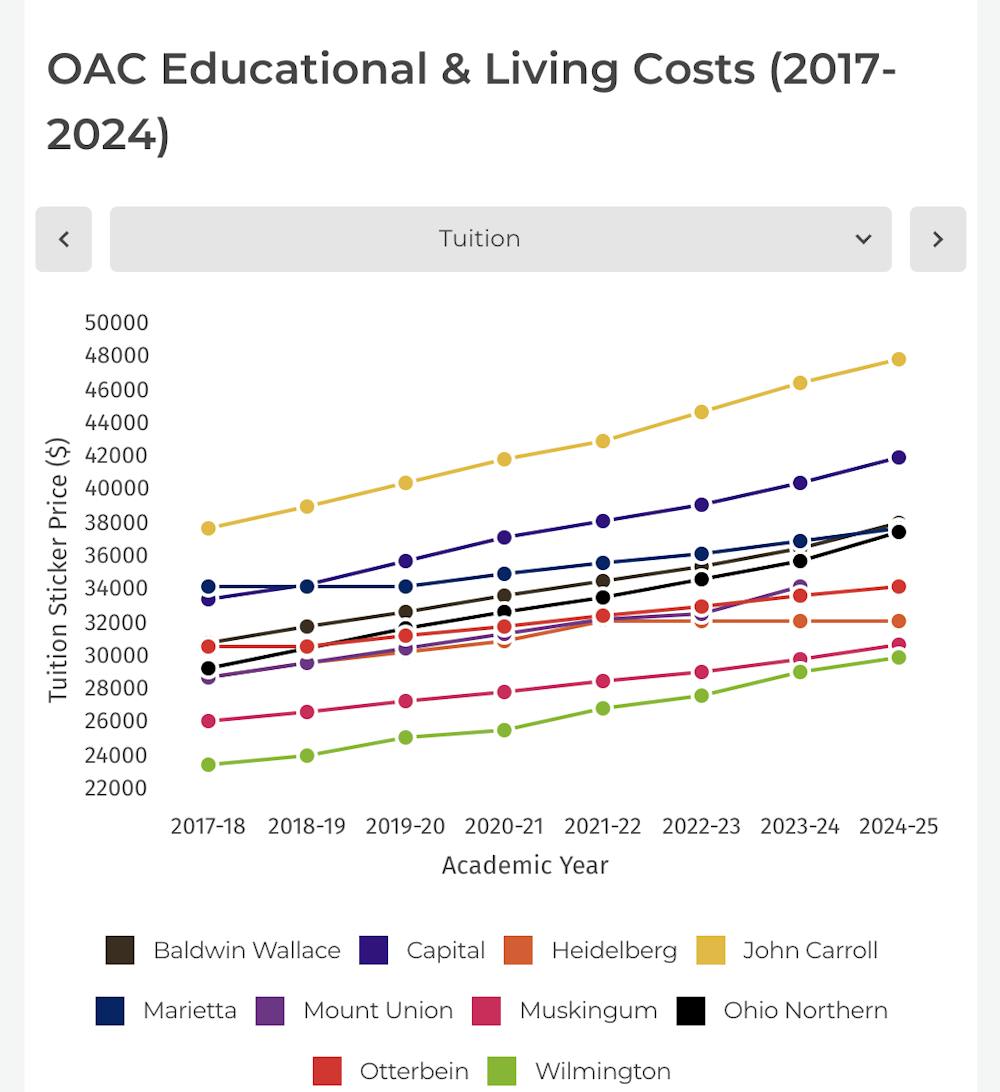As Otterbein begins considering adjustments to tuition in the future, it must balance its goals for affordability with consumer perceptions.
Increasingly expensive tuition has been a point of contention for decades, and at private colleges in particular, the advertised sticker price can be deceptive and lead students from underrepresented backgrounds to miss out on opportunities for higher education.
In recent years, Otterbein has been working to communicate affordability to students with lower incomes through its need-based aid programs. For example, 2019 marked the start of the Opportunity Scholarship, which covers tuition costs for certain low to moderate-income students after grants, scholarships, federal and state aid, and loans.
More recently in fall 2023, Otterbein began a loan-free program which covers tuition costs for students receiving the Ohio College Opportunity Grant (OCOG).
“[The program] has led to more enrollment from first gen, low-income students, more students of color or more students from Columbus City Schools, more diversity in our classes,” Otterbein president John Comerford said. “And in the environment, where there's not enough 18 year olds to go around...You’ve got to open the door wider to under served populations to have any chance at growth. And so the fact that those numbers have grown says to us that it's working.”
However, despite Otterbein making efforts to reach out to students from underprivileged backgrounds, it remains stuck in a high tuition because the high aid model has continuously excluded students with lower incomes.
Data from the National Center of Education Statistics, comparing the tuition of public colleges and private non-profits, found more than a $25,000 difference in the average annual tuition in the 2020-21 school year.
Where public universities receive funding from the state and federal government, private non-profit universities rely on donations and tuition. There are many reasons for the high cost of higher education, however, in a market culture where higher prices can be associated with quality, some institutions raise their rates to compete for students.
However, the prices advertised by private colleges tend to be misleading since many of these institutions follow a high discount model, meaning students don’t pay the sticker price.
Between the schools in the Ohio Athletic Conference (OAC), for example, total costs of attendance in 2021, including tuition, fees and, room and board, ranged from $40,000 to $58,000. However, the average net cost of attendance or the price students actually paid, ranged from $19,000 to $30,000, with aid covering 40% or more of most students’ expenses.

Further, the significant discount rates included in many financial aid offers tend to be merit based rather than need based. These discounts, however, are not always apparent to students looking to enroll in college for the first time and the lofty sticker prices can deter students from applying to private colleges, leading them to attend non-selective colleges where they may end up paying more than at a high discount private institution.
“I think there definitely is an issue with tuition when you look at like, the history of schools and stuff and you compare countries. We are one of the only...super developed countries that doesn’t really have affordable colleges,” said sophomore psychology major Drakko Harper. “And I would say it's like an overall issue with just the government, like not regulating things enough...any sort of business, whether it's health care [or] education, kind of just make up prices to increase its profits.”
Multiple factors play into colleges’ reasoning for using a high tuition, high aid model, including trying to attract affluent, high-achieving students. Besides limiting diversity in applications, this model presents other problems.
“In order to chase the best and brightest, you're typically doing that through financial aid; you're giving more and more aid away and you're accepting less and less revenue per student. Then those same students who are from suburban high schools and have had a lot of privilege in life, expect a campus that's built like Disneyland...” Comerford said. “And so you're stuck between a declining revenue per student and an increasing cost of operating your Disneyland campus.”
According to Comerford, Otterbein has looked into reducing the sticker price to what the average student pays by getting rid of merit scholarships and having everyone pay the same rate.
“We did market research on that. And the answer was: people wouldn't like that. Everyone likes to feel special...And no one wants to go to the cheap school,” Comerford said. “People think the higher the sticker price, the better the school, even though that's nonsense. It depends on what your actual out of pocket is...The problem is that Otterbein by itself is sort of stuck in this marketplace, where we have to play the same game to some extent.”
Currently, Otterbein’s published tuition price for the 2024-25 school year is $35,024. Next year’s tuition rates in OAC schools range from under $31,000 to over $48,000.
Since 2019, Otterbein’s tuition has consistently increased $600 each year following a five year tuition freeze at $31,424. However, other OAC schools have increased tuition as much as $1810 in a single year over the last several years.
While Otterbein’s $600 increases were part of an effort to promote tuition transparency, in which families could anticipate and plan for the changes in tuition, Otterbein now faces a debate as it tries to figure out how to keep its sticker price from becoming cheaper than other universities while also not burdening families with any large increases.
While this matter will be for the Board of Trustees to decide next year, students like Harper ask that they consider student opinion.
“If you really value students, and you want them to be able to, you know, fund this education...I think you have to actually, like have a forum, have a space for sort of all students to be able to contribute ideas and like to be able to give their input,” Harper said.








